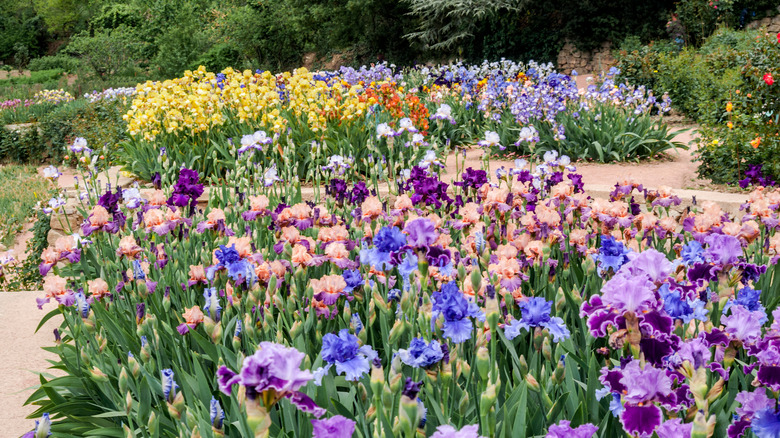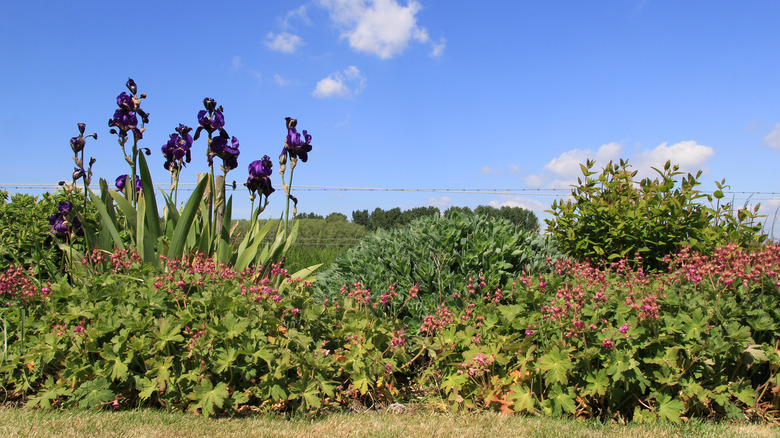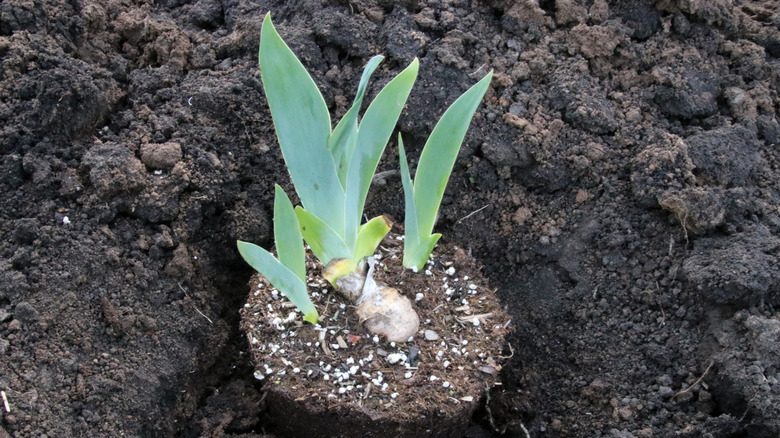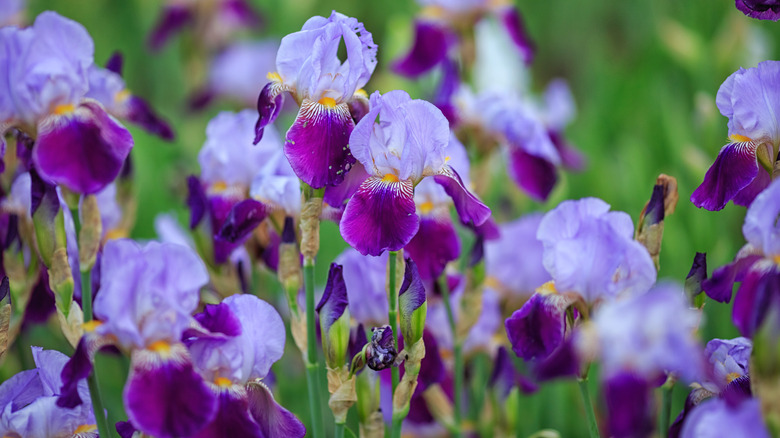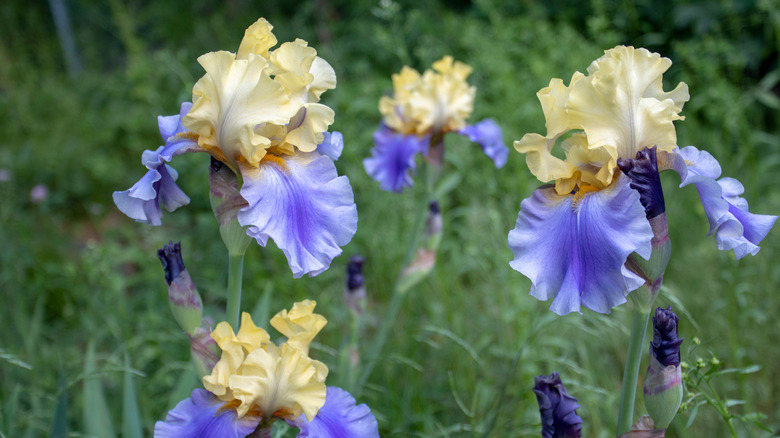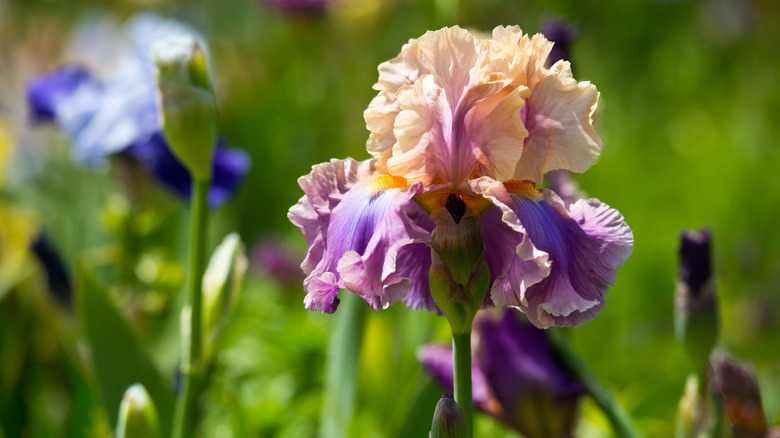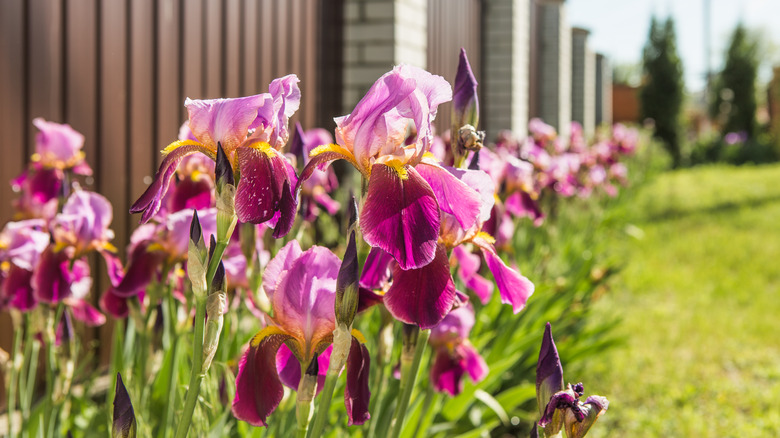How To Grow And Take Care Of A Bearded Iris
Bearded iris, or Iris germanica, add color, height, and a sense of playfulness to any garden, so it's no wonder that gardeners everywhere love this flowering plant. As their name implies, bearded irises have ruffled petals that resemble beards, but irises also come in beardless and crested varieties that have a sleeker look. These flowers come in just about every color imaginable, including red, yellow, blue, white, pink, purple, and more, according to The Spruce.
Native to Southern Europe and the Mediterranean, bearded irises grow from rhizomes, which are underground stems from which the roots emerge. The plants feature long, pointed leaves, and flowers with frilly multicolored petals. These plants are perennials, meaning they grow back on their own each season, but they do need to be divided every few years. Otherwise, bearded irises are considered low-maintenance plants and require little care other than occasional watering. Able to reach heights up to 40 inches tall, bearded irises are sure to stand out in your garden.
How to use bearded iris in garden
Bearded irises make for beautiful garden plants because of their vast array of colors, stand-out petals, and impressive height. These flowers are perfect for any ornamental garden and make great companions for many other flowering garden plants. They coexist well with plants that require similar growing conditions, such as full sun. The English Iris Company gives some examples of similar plants that work well with bearded irises, such as poppies, peonies, and daisies.
Because bearded irises are tall and can reach up to 40 inches in height, they work great as border plants in your garden. They look amazing with other tall plants such as alliums, delphiniums, foxgloves, and lupines. Bearded irises also stand out when planted behind shorter plants such as columbines, violas, tulips, and lavender. No matter how you decide to use bearded irises in your garden, they are sure to capture attention with their breathtaking ruffled flowers and bright, cheerful hues.
How to grow bearded iris
Growing bearded irises is simple, but there are a few things you should keep in mind. Bearded irises grow from underground stem structures called rhizomes, which should be planted in the late summer or early autumn months for the best results, explains Holland Bulb Farm. Plant your rhizomes 12 to 18 inches apart, and a 1/2 inch deep in well-draining soil. If you plant your rhizomes too deep or don't use well-draining soil, they may experience root rot. After planting, water the fledgling plants regularly to help them get established. Your flowers will bloom the following spring.
Better Homes & Gardens explains how to divide and propagate your bearded irises, which is recommended every three to five years. You can tell when it is time to divide your bearded irises when their bloom rate begins to slow, which indicates that the original rhizome has started to die. Dividing and replanting will keep the plant blooming regularly. First, dig up the bearded iris and divide their rhizomes with a sharp knife, making sure that each section is at least an inch thick and has a few leaves. Discard any sections that show signs of decay. When replanting, cut the leaves down to at least a 1/2 foot so the plant can focus on new growth. Replant the iris in a new hole with the roots fanned out and the rhizome sitting just below the soil surface.
How to care for bearded iris
Bearded irises are considered incredibly easy to take care of, as they are a very low-maintenance plant. When planting your bearded irises, take care to place them in an area where they will receive full sunlight so that they can bloom regularly. American Meadows explains that they need occasional watering before they begin flowering, but once the plants are established, they can survive on rainfall alone. These plants also don't need regular fertilizing; only the reblooming variety needs fertilizing in the spring after the initial flowering ends and new growth begins.
The primary maintenance that bearded irises require is regular deadheading and division every three to five years. After the flowers begin to fade, they should be cut off. If you have a reblooming variety of bearded irises, this will encourage a second round of blooms. At the end of the season, cut the leaves and stems down to about 6 inches. This will also prepare the plants for division, which can be done at any time, but experts recommend dividing about six weeks after flowering has ceased.
Varieties of bearded iris
Bearded irises make a perfect garden plant because there are many varieties to choose from. These flowers are available in a wide range of colors, and Gardenia explains some of the most popular varieties.
-
Iris "Clarence": These stunning flowers feature contrasting white and purple-blue petals and a sweet fragrance.
-
Iris "Hello Darkness": As their name implies, this variety of bearded irises has dramatic, dark purple-black petals, making them sure to stand out in your garden.
-
Iris "Absolute Treasure": In contrast to Iris 'Hello Darkness', this pastel variety features heavily ruffled pale blue or purple petals.
-
Iris "Edith Wolford": A truly unique variety of bearded irises, these flowers have bold yellow and purple contrasting petals.
-
Iris "That's All Folks": This variety of bearded irises is a showstopper with ruffled white petals edged with bright yellow.
-
Iris "Celebration Song": With bright pink petals edged with lavender, these flowers are a perfect addition to a romantic, sunset-colored garden.
Is bearded iris toxic?
Although bearded irises make a great addition to any ornamental garden, they are not safe to be consumed by humans or pets, according to ACEP Now. When consumed in small quantities by humans, bearded irises can cause mild symptoms such as skin irritation, nausea, vomiting, abdominal pain, and diarrhea. To avoid these symptoms, make sure never to consume your bearded irises, and keep them out of reach of young children who may try to eat them.
The symptoms of toxicity in humans may be mild, but bearded irises can cause more extreme illness or even death in pets, both dogs and cats alike. If your pet ingests bearded irises, they may experience diarrhea, vomiting, decreased appetite, ulcers, or bleeding of the stomach or small intestines. If you suspect your pet has consumed some of your bearded irises, it is necessary to get them veterinary attention immediately. For the safety of your pets, make sure to plant your bearded irises in areas your animals cannot access.
How to repot bearded iris
Bearded irises are not typically grown in containers, but it is possible to achieve and maintain happy and healthy plants. You'll need a container large enough to house the irises' extensive root system, per Gardening Know How. It's also important to ensure your potted irises have the proper growing conditions, including full sunlight and well-draining soil. You may also need to use garden stakes to provide them with additional support as they grow.
Generally, you should only repot your irises every three to five years when it is time to divide the rhizomes. To repot your bearded irises, dig up the original plant and rinse the soil from the roots. Divide the rhizomes, following the instructions above. Then you can replant your irises into different pots. For best results, place the rhizomes near the surface of the soil so they are just barely visible. Plant each rhizome at least 6 inches apart and water the soil after replanting. Continue with regular bearded iris care, such as deadheading any faded blooms. To protect your potted irises during the winter months, you can cover them with mulch. Following these steps will help ensure that your bearded irises bloom beautifully the following year.
